#Filipino Christmas
Explore tagged Tumblr posts
Text
Day 22: Today's Storybot Fun Fact is... 💡

As a huge fan of Christmas, I'm packing my bags.


#storybots#storybots fanart#storybots franklin#storybots fun fact#christmas#filipino christmas#shoutout to the philippines#they love their christmas#StorybotCember2024#missed opportunity to put the screenshot on the speech bubble but i didnt have the idea before i posted it
20 notes
·
View notes
Text
Filipinos as soon September arrives: Christmas time!!!

52 notes
·
View notes
Text
Simbang Gabi: The 9 Days Before Christmas
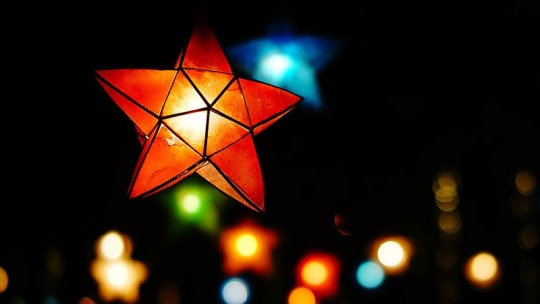
An image of a red parol from Peakpx.com
The Philippines is well-known for its extremely long Christmas celebration that a lot of foreigners often look at with confusion. Traditionally, Filipinos may start putting up their trees, playing festive songs, and counting down to the 25th as early as September in a season that's colloquially called the "ber months" or the "ber months season" (Petrelli, 2021). This period often lasts up until January or February where some houses may still keep their trees and decor pushing as far as March.
Even with this technicality, however, you'd be hard-pressed to find Filipinos truly celebrating from the very beginning of September genuinely ending it by the end of February. Most often, actual celebrations start after Undas, a period encompassing All Saints' Day and All Souls' Day on the 1st and 2nd of November respectively to commemorate the dead, similar but a lot more subtle than other Catholic countries own Day of the Dead like in Mexico's Dia de Los Muertos and Italy's Giorno dei Morti. This time period is often the start of people doing more Christmas-y things such as Kris Kringle activities leading up to the main Christmas party.
The main markers of the true start in itself is the Advent season, which starts on the Sunday nearest to the 30th in Western Churches like Roman Catholicism and leads up to Christmas ("Advent", n.d.). This is where Catholics would go to Church every Sunday leading up to Christmas to light the Advent Wreath until the final candle on its center on Christmas day on the 25th. As the Philippines is heavily influenced by Roman Catholicism, Filipinos follow the Western start of Advent and most celebrations often fall in the middle of this time period. Even the middle of Advent, however, Filipinos have a waiting period to count down before Christmas - Simbang Gabi.
What is Simbang Gabi?
Simbang Gabi (en. night mass; going to mass at night) is a Philippine Christmas tradition wherein Roman Catholic Filipinos would attend mass nine days every single morning or night before the actual Christmas celebration. Traditionally, the masses were held every morning at 4:00 AM from the 16th to the 24th which would then be capped off by Christmas Eve Mass at night or Christmas Mass on the 25th with its early schedule earning it the name Misa de Gallo (en. mass of the rooster) (Lazaro, 2020). In most dioceses, however, they often have an anticipated mass schedule that start a night earlier than the morning masses (Hermoso, 2022).
Besides being called Misa de Gallo, I had also heard the celebration being called Misa de Aguinaldo (en. mass of gifts) in some places. This shares the same name as the similar Puerto Rican tradition Misa de Aguinaldo which is also a nine-day mass held in the morning, typically at 5:00 AM which is also deeply-rooted in Puerto Rican Christmas traditions (Álvarez, 2018).
History
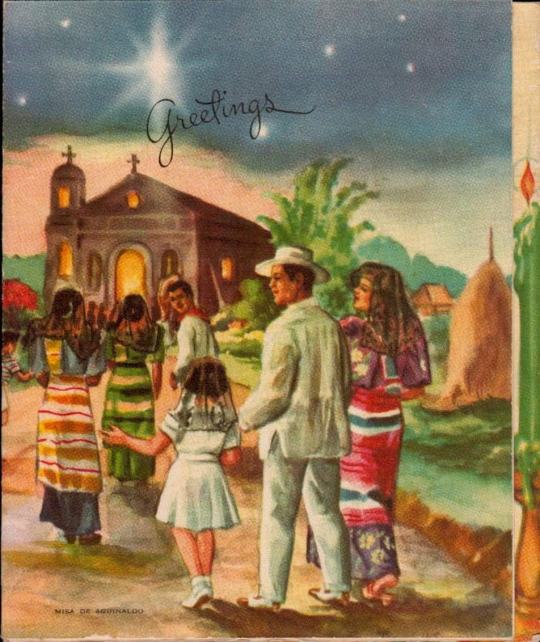
A vintage greeting card posted by the Facebook group Vintage Philippine Islands 1920-1959 (2020)
Being a Christmas tradition, it is not surprising that Simbang Gabi could trace itself back to the Spanish colonial period.
A common misconception of its origins states that the practice first started in Mexico. Hermoso (2018) states that it started on the year 1587 by Friar Diego de Soria of the Convent of San Agustin Acolman when he requested the Vatican to allow church service to be held outdoors because of an overflow of attendees during the Christmas time. Pope Sixtus V later approved of this request and even decreed that these kinds of masses be held in the Philippines at the dawn of the 16th of December. What this doesn't account for was that the practice of going to church for the Eve of Christmas dates back to even earlier than the 16th century.

The cover for an English translation and compilation of Etheria's writings by M.L. McClure and C.L. Feltoe, D.D. (1919)
The first recorded instance of Christians celebrating Christmas by going to early mass leading up to the actual date was first written by Egeria (also called Egeriae, Etheria, or Aetheria), a Christian Galician woman who first recorded it during her travels to the Levant where she notes the early morning masses and festivities from the time of the Epiphany to the Nativity. She writes in her letters later called the Itinerarium Egeriae (en. The Travel Guide of Egeria; The Pilgrimage of Etheria).
"Octave of the Festival. On the second day also they proceed in like manner to the church in Golgotha, and also on the third day; thus the feast is celebrated with all this joyfulness for three days up to the sixth hour in the church built by Constantine (...) And in Bethlehem also throughout the entire eight days the feast is celebrated with similar festal array and joyfulness daily by the priests and by all the clergy there, and by the monks who are appointed in that place (...) and immense crowds, not of monks only, but also of the laity, both men and women, flock together to Jerusalem from every quarter for the solemn and joyous observance of that day." - Egeria, 381-384; The Pilgrimage of Etheria (trans. McClure & Feltoe, 1919):
The practice of attending early morning masses up until the main festivities of the Nativity was later adopted by more Western Christian communties during the time of Pope Sixtus III when he celebrated what is widely considered the first Midnight Mass at the Basilica of St. Mary Major in Rome, not only stemming from the popularity of the Christians from Jerusalem but also the popular belief that Jesus was born at midnight (The Pillar, 2021).
The prayer spoken within the midnight vigil was then called the "mox ut gallus cantaverit" which translates to "when the rooster crows", aptly named because of the early hours the vigil tended to last which then coincided with the crowing of roosters ("Misa del Gallo: origen, historia y por qué se celebra en la madrugada del 25 de diciembre", 2022). The practice was continued by the Spanish with the name Misa de Gallo (also called Misa de Aguinaldo)which later spread throughout the Spanish Empire and could now be seen practiced in countries like Bolivia, Puerto Rico, Venezuela, and of course the Philippines.
There seem to be two variations of this: the nine-day series of masses before Christmas (found in the Philippines, Puerto Rico, and Venezuela) and the single early morning mass before Christmas day (found in Spain and Bolivia). It isn't clear if Spain and Bolivia simply dropped the nine-day tradition or if the nine-day tradition was restarted in these other colonies, however.
In the Present Day

An image of crowds outside a church during Simbang Gabi uploaded to Wikimedia by Erwin Malicdem
Today, the Simbang Gabi continues to be a popular tradtion for most Filipino Roman Catholics, even those who aren't typically as religious most parts of the year. This is given the fact that a popular belief is that when a person completes all of the nine days, they may receive a wish to whatever they desire. This is such a common belief that Bishop Broderick Pabillo, a Manila auxiliary bishop, had to remind people that the point of the tradition is to remember Jesus and his nativity (Punay, 2016). Besides this, it is also a common challenge among Filipinos to try to complete it as is or see how many days out of the nine could they actually attend.
It is not uncommon for churches these days to hold an "anticipated" mass the night before the actual date starting instead on the 15th and ending on the 24th with a Christmas mass, instead of starting on the 16th and ending on the 25th. This newer tradition had come from the reign of Filipino dictator President Ferdinand Marcos Sr. during the Martial Law years in the 70s, when Filipinos were not allowed to go out after a curfew until 4 in the morning (Macairan, 2023). This allowed more people and especially those who may not be able to start their day early or those who may have other obligations in the morning to attend masses at night time, typically at around 6 PM - 8 PM.
The only large controversy that I could remember about Simbang Gabi was back in 2011 when the event was banned from being conducted within the Philippine Center in New York City. The ban came about because of it supposedly violated Canon Law which prohibits religious worship in unconsecrated ground or in other words places that aren't seen as places of worship. In an article by Adarlo & Pastor (2014), Rev. Dr. Joseph G. Marabe, the at-the-time head of the Chapel of San Lorenzo Ruiz and a priest-in-residence at St. Patrick's Cathedral where the ban took place, explains in an interview with news site The FilAm:
"It’s not allowed by law to have Holy Mass in an unconsecrated place. Worship should take place in a sacred place. That was an explanation but not a decision. The Archdiocese decides." - Rev. Dr. Joseph G. Marabe, head of the Chapel of San Lorenzo Ruiz in Chinatown, New York (2011)
The ban was later lifted on 2014 after community leader Loida Nicolas Lewis wrote a letter to the diocese to reconsider the ban which led to the return of the almost 30-year-old tradition that year (Balitang America, ABS-CBN North America Bureau, 2014).
Besides being a huge part of current traditions, a lot of Filipinos, and especially Filipino youth, use the event as an excuse to go out during the night to hang out with friends and even go on dates with their partners. It is not an uncommon sight to see a group of teenagers, often wearing maybe less than typical church clothes, by the edge of the Church seemingly attending mass. Whether or not they're actually being attentive is hard to decipher. Either way, this has led to an explosion of memes almost every year just mocking these kinds of people or making fun of their own.

A screenshot of the "Simbang gabi starter pack" posted by user rhapido on 9Gag.com (2022)
Earlier versions of this meme could be seen posted throughout Filipino social media during the early 2010s
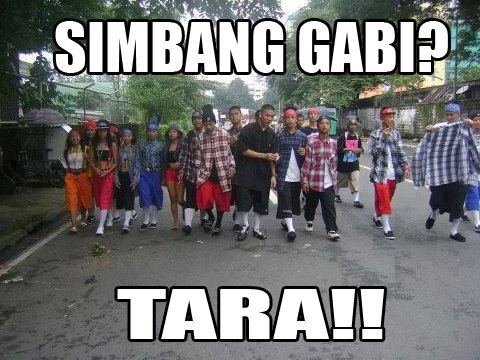
A meme posted by the Facebook page FEU Memes (2012)
The barkada (en. friend group) going to Simbang Gabi had been an older tradition that has found a lot more popularity in the contemporary era because of social media. My mother had told me that she used to use it as an excuse herself back in the 80s to hang out with her friends at night time. This may be a continued past time for especially younger people for years to come.
There's also many street foods associated with Simbang Gabi that may not be unique to the event itself but are nevertheless heavily associated with the event due to their widespread sale during this time period. Foods like bibingka, puto bumbong, kutsinta, and other popular rice cakes dominate the scene which definitely satisfy the hungry parishioners who had, most likely, not eaten breakfast or dinner before going to church. With their strong associations with Simbang Gabii and Filipino Christmas as a whole, I might discuss these on a later date.
Simbang Gabi, from my experience
Growing up and living in the Philippines and especially being raised Catholic within a Catholic town named after a Catholic saint and going to a Catholic school named after another Catholic saint, it probably won't shock you that I, myself, had tried to complete the nine days of Simbang Gabi myself. I had attempted it several times with only maybe trying seriously by myself once in my life. It was quite the experience to just try to dedicate yourself into completing a goal to do something for nine consecutive days straight.
My first attempt was when I was in Junior High and it was with my sister and two people who worked for my parents and had helped watch over us. It was something that I always wanted to try doing and especially since I was gaining a lot more independence at the time so what better to try it out without the rest of the family? With adult supervision, of course.
Since we lived quite away from the actual church, the place was already packed even an hour before the actual mass started. There was barely any seats left and even less standing room leading to a huge overflow of people stuck outdoors, only hearing mass from the outdated speaker system that they had erected in place of the old bell tower.
The mass in our church was often done in the dark during the night out of an deliberate and probably aesthetic choice with only the alter being illuminated by the lights. The rest was lit up by the scattered about Christmas decor throughout the church and the church patio. It always felt like going to some liminal space that other nights at church just doesn't give.
Once the mass has been concluded, people rush out of the doors in thick crowds to find their way into the footpaths leading on to the main town streets. Some opt to stay behind to enjoy the food stalls that had pop-up for the night to eat bibingka, puto, sapin-sapin, and palitaw among other things. Some of the teens had decided to raid the nearby small park and playground as a hang-out spot to talk the night away before they rush home for their curfews. Meanwhile others were just rushing to get home as soon as they can, with people lining up to go to the rudimentary parking space that the church created while the others who didn't own their own vehicles forced to compete for the very few commuter vehicles still riding through the night, hunting for passengers.
This was before we had our own car, so we were with the latter crowds of people, trying to peer through the dark streets only illuminated by the scant Christmas lights that still refused to turn off as the night progressed. Every so often, two headlights excite the crowd and a swarm of them start running in anticipation with not care or tact if they would crush children or separate families all to take a seat on the night jeepneys, some the few commutes left after 9.
My sister was an expert in finding her way through it, reaching out to the doors to form a barricade for herself and the rest of us to prevent others from taking our seats before letting herself in. I still think I would've been left behind if it weren't for her doing that out of sheer competitiveness with the crowds.
We settled into our seats and squeezed in tightly to allow other passengers in so we could all go home as soon as we can. It was a tight but otherwise uneventful commute every night with nothing but tired people waiting for their stops and slowly emptying the once packed vehicle. Since we live in the outskirts of the town, we were often the last few and at times, the drivers would transfer us to other jeeps just so they can go home themselves. This had sometimes instead left us to walk the remainder of the way there through unpaved highway sidewalks.
After a few nights of it, I became more and more reluctant to continue because of the frenzy that it had almost every single night and it was extremely inconvenient for my time and the time of those with me. I didn't complete it then and I hadn't seriously tried until 9th Grade, which honestly was more uneventful.
That attempt was mostly my siblings and I staying in Makati City and Taguig City and going to easily traveled to churches that we could walk to by foot, and high-end malls that have annual Simbang Gabi masses for their shoppers, facilitated by the local diocese and the local fancy church. I was able to complete those easily because I was often dragged either by my siblings or my grandmother who used to never miss a day of church when she was still more active.
It was less about the challenge at that point and more of an obligation which isn't a bad thing and honestly is probably closer to how it should be celebrated.
I hadn't gone to Simbang Gabi since 2019 and I don't have any plans to try this year either. Not really because I don't want to necessarily, but specifically because I physically can't. I still think its pretty fun to do and honestly maybe a good excuse to meet with my friends that I haven't seen in a while. Sadly, I just simply cannot do it now nor in the near future.
Maybe one day I could once again go out at those cold December night to meet my friends and maybe eat some bibingka on my way home but I guess I'll just leave every one else to it.
Sources
Introduction
Advent. (n.d.). In Britannica. Retrieved on 13 December 2023, from https://www.britannica.com/topic/Advent
In The Philippines Christmas Eve Includes A Late Night Street Food Feast, Filipino Christmas, HD wallpaper [image]. (n.d.). Peakpx. Retrieved on 15 December 2023, from https://www.peakpx.com/en/hd-wallpaper-desktop-wxdle
Petrelli, M. (2021, December 20). The country that celebrates Christmas for more than 4 months a year. CNBC. Retrieved on 13 December 2023, from https://www.cnbc.com/2021/12/21/philippines-the-longest-christmas-celebrations-in-the-world-.html
What is Simbang Gabi?
Álvarez, F. (2018, November 22). Una tradición matutina la Misa de Aguinaldo. Primera Hora. Retrieved on 13 December 2023, from https://www.primerahora.com/noticias/puerto-rico/notas/una-tradicion-matutina-la-misa-de-aguinaldo/
Hermoso, C. (2022, December 15). 9-day ‘Simbang Gabi’ begins on Dec. 16; anticipated masses to begin tonight. Manila Bulletin. Retrieved on 13 December 2023, from https://mb.com.ph/2022/12/15/9-day-simbang-gabi-begins-on-dec-16-anticipated-masses-to-begin-tonight/
Lazaro, J. (2020, December 11). The Christmas tradition of Simbang Gabi: After five centuries, this Filipino Christmas tradition lives on. U.S. Catholic. Retrieved on 13 December 2023, from https://uscatholic.org/articles/202012/the-christmas-tradition-of-simbang-gabi/
History
Hermoso, C. (2018, December 15). ‘Simbang Gabi’ a manifestation of the Filipinos’ strong faith in God, says bishop. Manila Bulletin. Retrieved on 13 December 2023, from https://mb.com.ph/2018/12/15/simbang-gabi-a-manifestation-of-the-filipinos-strong-faith-in-god-says-bishop/
Etheria (1919). The Pilgrimage of Etheria (McClure, M., & Feltoe, C. Ed. & Trans.). Society for Promoting Christian Knowledge. Retrieved on 13 December 2023, from https://www.ccel.org/m/mcclure/etheria/etheria.htm (Original work published 384 C.E.)
McClure, M., & Feltoe, C. (1919). [An image of the book cover of "The Pilgrimage of Etheria"]. Retrieved on 15 December 2023, from https://www.ccel.org/m/mcclure/etheria/etheria.htm
The Pillar. (2021, December 21). What time is Midnight Mass?. The Pillar. Retrieved on 15 December 2023, from https://www.pillarcatholic.com/p/what-time-is-midnight-mass
Misa del Gallo: origen, historia y por qué se celebra en la madrugada del 25 de diciembre. (2022, December 24). Marca. Retrieved on 15 December 2023, from https://www.marca.com/tiramillas/actualidad/2022/12/24/63a6c106268e3e7c468b45e8.html
Vintage Philippine Islands 1920-1959. (2020, December 25). A Vintage Greeting Card showing Philippine Christmas… Maligayang Pasko from Vintage Philippine Islands 1920-1959 [image]. Facebook. Retrieved 15 December 2023, from https://www.facebook.com/510513375695362/photos/a.1701322009947820/3595821097164559/?type=3
In the Present Day
Adarlo, S., & Pastor, C. (2014, November 3). Fr. Joseph Marabe breaks silence over Simbang Gabi ban (Part 2). The FilAm: A Magazine for Filipino Americans in New York. Retrieved on 15 December 2023, from https://thefilam.net/archives/16127
Balitang America, ABS-CBN North America Bureau. (2014, September 19). Simbang Gabi returns to NYC after a brief ban. ABS-CBN News. Retrieved on 15 December 2023 from https://news.abs-cbn.com/global-filipino/09/19/14/simbang-gabi-returns-nyc-after-brief-ban
FEU Memes. (2012, December 15). eto yung mga madalas ko makita sa gilid ng simbahan e [image]. Retrieved on 15 December 2023 from https://www.facebook.com/PIYUMEMES/photos/a.210778985704527/317211885061236/?type=3
Macaira, E. (2023, December 15). Simbang Gabi: It’s the mass, not the time. Philippine Star. Retrieved on 15 December 2023, from https://www.philstar.com/headlines/2023/12/15/2318980/simbang-gabi-its-mass-not-time
Malicdem, E. (n.d.) The Bamboo Organ Church or the St. Joseph Parish Church of Las Piñas City in the Philippines during "Simbang Gabi" or Night Mass on Christmas eve. Photo was part of Schadow1 Expeditions coverage of Las Piñas during Christmas season. [image]. Retrieved on 15 December 2023 from https://en.wikipedia.org/wiki/Simbang_Gabi#/media/File:Las_Pinas_Church_during_Simbang_Gabi.jpg
Punay, E. (2016, December 19). ‘Simbang Gabi’ won’t grant wishes – Bishop. Philippine Star Global. Retrieved on 15 December 2023, from https://www.philstar.com/headlines/2016/12/19/1654920/simbang-gabi-wont-grant-wishes-bishop
rhapido. (2022, November 30). Simbang gabi starter pack [Screenshot]. 9Gag. Retrieved 15 December 2023, from https://9gag.com/gag/a5Xnzgr
#mayaposts#mayapino#philippines#filipino#history#philippine history#filipino history#christmas#filipino christmas#philippine christmas#simbang gabi#misa de gallo#misa de aguinaldo#long post#very long post#christianity#catholicism#roman catholic#christian history#food mention
24 notes
·
View notes
Text
September 1: *arrives* Filipinos, immediately:
youtube
youtube
youtube
#philippines#filipino#filipino culture#christmas#christmas season#christmas culture#filipino christmas#ber months#september 1#merry christmas#merry xmas#maligayang pasko#Youtube
3 notes
·
View notes
Text

A friendly reminder for my fellow citizens of the Philippines out there!
3 notes
·
View notes
Text


Above photo taken 9/18/2023.
#Midwest memes#Ber months#maligayang pasko#filipino christmas#upper peninsula#michigan#jose mari chan#first day of autumn#it’s fall y’all
8 notes
·
View notes
Text
Christmas vibe at LU




17 notes
·
View notes
Text
youtube
The Philippines:

#hey arnold#nicktoons#i hate the snow#lou rawls#filipino christmas#maligayang pasko#merry christmas#christmas#Youtube
0 notes
Text
instagram
And no, my pet Pomeranian Ash doesn’t do an ecarte devant 200-degree side layout in a bra top and booty shorts over bare legs.
Taken 11/9/2024.
#maligayang pasko#ber months#pomeranian#filipino christmas#dogs of instagram#interpretive dance#fat coda studios#Instagram
0 notes
Text
MALIGAYANG PASKO
(Merry Christmas)
youtube
#philippines#christmas#filipino#filipino christmas#filipino christmas songs#christmas songs#2d animation#animation#animated#christmas animation#filipino animation#digital art#artists on tumblr#digital painting#digital illustration#animation special#filipino artists#filipino culture#tagalog#Youtube
17 notes
·
View notes
Text
Celebrating Christmas in the Philippines: The Christmas Capital of Asia (Part 1)
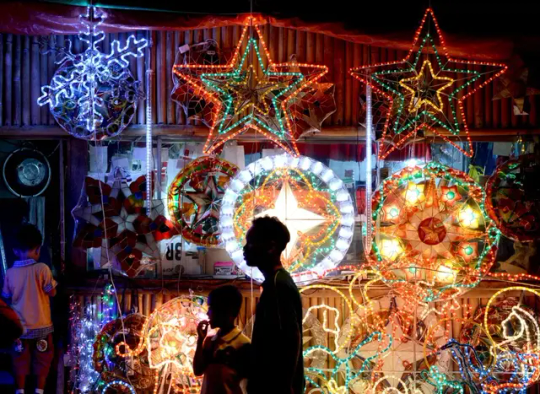
A store in the Philippines that sells Filipino Christmas decorations sourced AFP Photo/Noel Celis, posted by Ana Catalina Paje (2021) via Yahoo! News
Filipino Christmas is notorious worldwide for being some of the longest celebrations of the holiday in the world. Often said to start on the month of September and ending at around February, being the main event for almost half the year is nothing to sneeze at. Even with this, how much do you know about Filipino Christmas exactly?
Just like all Christmas traditions from all around the world, the Filipino way is rooted in long tradition and history that stems from colonial, and postcolonial practices that continue to evolve into the present day with many more additions in the future.
Before I start
As usual, it is important for me to recognize that the Philippines is a diverse country with different cultures, traditions, and histories with each community having their own unique practices and experiences with the holidays. There is no way for me to fully encompass every single experience that every Filipino has for this holiday as well as the experiences of those who don't even celebrate the holiday. This is besides the fact that uncovering sources for more specific traditions or practices may be either difficult or impossible for me to access easily.
I also want to note that not all Filipinos celebrate Christmas such as Filipinos of different religious backgrounds such as Muslim, Hindu, Buddhist Filipinos, or of different denominations that may not celebrate Christmas such as members of some Protestant denominations.
I also had to split up this post into two parts because Tumblr wouldn't let me make extremely long posts. Part 2 is linked here.
With that being said, feel free to add your own stories and experiences to this post if you have any to share or even information that I may not had discussed at all.
(This was supposed to go live on the 25th but it got delays because of personal stuff sowwyyyy. I'll just reblog this for next year too lol)
Etymology
In the Philippines, Christmas is primarily called pasko with the season itself called kapaskuhan . It comes from the Spanish word pascua, from the phrase pascua de navidad. Pascua comes from the Latin pascha which then comes from the Greek πάσχα (páskha) which then came from Hebrew's פסח (pesach) originally referred specifically to Passover (Vivas, 2021).
From pascua and, by extension, pasko's usage to refer to Easter (i.e. pascua de resurrección and pasko ng pagkabuhay respectively), the word was then later used to refer to Christmas (i.e. pascua de navidad) as the word often referred to the celebratory aspect of the holiday. The Spanish brought over the dual usage of the term for both holidays during the colonial period.
Certain variations of the word around the country typically follow the same root with pasku or pascu being used in Kapampangan, a closely related language to Tagalog, and some other languages keeping the usage of pascua like the Spanish creole language of Chavacano.
Filipinos today often interchange the usage of pasko and Christmas when discussing the holiday, and sometimes may use an informal Filipinized spelling of Christmas as krismas by spelling the English word by sound (a trait of a lot of Filipino languages) which mimics a Filipino accent but I honestly had not seen this in a while.
History
Surprisingly,according to legend, the story of Christmas in the Philippines doesn't start on 1521, the year Ferdinand Magellan landed on the island of Cebu, nor the subsequent years after that, but on 1324, nearly 200 years before the Spanish came anywhere close to the Philippines islands.
In an old church called Saint James the Great Parish Church found in Bolinao, Pangasinan, exists a marker that makes the interesting claim that the first mass, and by extension the first mass in the history of the Philippines took place in the very place where the church now stood as a thanksgiving mass for their safe landing on the island (Sotelo, 2015). Ocampo (2012) states that there had been claims within Pangasinan folk legends that this first mass was also specifically the first Christmas mass that had taken place in the history of the Philippines which had embedded itself on the town of Bolinao's folklore.
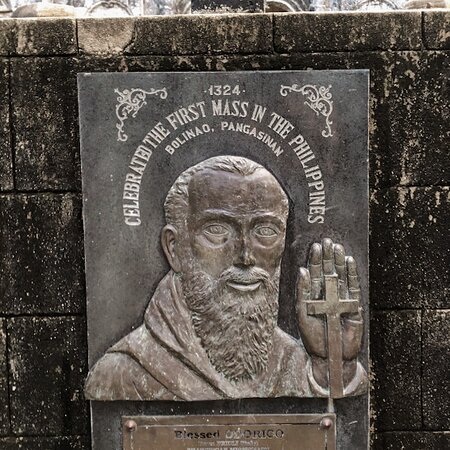
A photo of the plaque found in St. James the Great Parish, Bolinao, Pangasinan showing Fr. Odorico posted by Vera Bajado (2021) via TripAdvisor
The story goes that on a stormy night, during his missionary travels to Asia, Italian Franciscan friar and missionary Blessed Fr. Odorico of Pordenone landed on the islands to take refuge in the town to wait for the rains to pass. It is said that they had met "hostile natives" who later changed their disposition after he proved himself harmless. He later celebrated the mass with his crew and the locals, people attributing these events to have taken place on the 25th of December (Yuvallos, n.d.). The full text for the marker that relays this story was transcribed by the blog Vagabonding with Chu (2017) and reads:
"Blessed Odorico From Friuli (Italy) Franciscan Missionary Born in Pordenone (Italy) around 1275 A.D. – Father Odorico, a courageous and religious Franciscan missionary pioneered the spread of the Gospel in Asia and China. He traveled always barefooted among indescribable difficulties and dangers exhausting his energies in the service of the Kingdom of God. In 1324, after landing and taking refuge in Bolinao, Pangasinan during a stormy weather, Father Odorico celebrated a thanksgiving Mass in honor of their safe journey and his mission. He also indocrinated and baptized many of the Malay immigrants in Bolinao. He returned home to Udine (Friuli) Italy after thirteen years mission. He died a holy death on January 14, 1331. His precious remains are kept in an artistic tomb of the parish church of our Lady of Mount Carmel, in Udine (Italy). Blessed Odorico, Pray for Us." - Marker in front of St. James the Great Parish Church
This claim is contested by historians including Ocampo (2012) who even adds that the additional parts of the story makes it much more unbelievable such as the claim that Fr. Odorico also planted the first Christmas tree which had not been a popular Christmas staple until the 19th Century. The National Historical Commission of the Philippines later affirms that the first mass did not in fact take place on Bolinao, Pangasinan but on Limasawa, Southern Leyte on Easter Sunday 1521 (Yumol, 2020).
The first Christmas mass most likely happened either a little after this time with a celebration possibly taking place during the stay of Miguel Lopez de Legaspi when arrived in the Philippines in an effort to start colonizing the islands. He was able to establish a Spanish settlement called the Villa del Santisimo Nombre de Jesús where he and his men lived in from 1565 - 1569 where celebrations for Christmas definitely must have taken place. The last of the Spanish forces in the country had also, incidentally, left from Cebu on Christmas day 1898 (The Freeman, 2021).
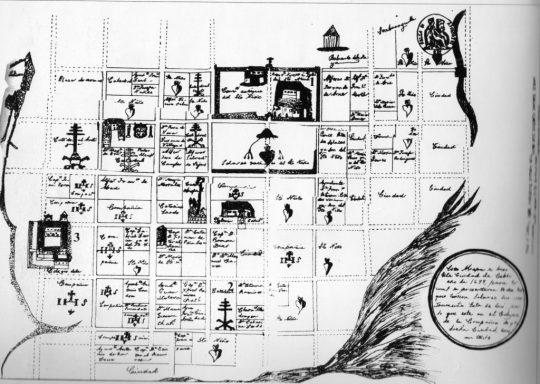
An old map of Villa del Santisimo Nombre de Jesús, now modern day Cebu posted by the Basilica Minore del Sto. Niño de Cebu (2017).
A lot of older traditions persist to the present day but the more modern-looking Christmas, much like in other Western Christian countries didn't become as popular until the late 19th to early 20th Century coming mostly from other European and American influences.
Traditions such as the Christmas tree had not existed in Filipino Christmas celebrations until the late 19th century, with the first seen mentions of it in the writings of Dr. José Rizal both in his translation of Hans Christian Andersen's work as well as a letter he had wrote home from Berlin to his sister Saturnina, who was called Neneng, and her husband Manuel, who was called Maneng, where he translates a story about a sad pine tree with the words"Ang Puno ng Pino" (en. The Pine Tree) next to two drawings of Christmas trees, Ocampo (2012) writes.
Ocampo continues to explain how Rizal wrote about the many German traditions that he had encountered in Berlin, including the decorating of a pine tree for Christmas. Ocampo later transcribes this letter in his article:
"There are some beautiful and good [German] customs, like Christmas, which gives me pleasure to describe here for it is not found in Spain and you have not read about it in Spanish books. On Christmas Eve they bring from the forest a pine tree, and this tree is chosen because, besides being erect, it is the only tree that keeps its leaves during winter—I say it badly; not really leaves, but a kind of needle. It is decorated with tinsel, paper, lights, dolls, candy, fruits, dainties, etc., and at night time, it is shown to the children (who should see the preparation of it), and around this tree the family celebrates Christmas." - Dr. José Rizal in a letter to his sister Saturnina Rizal and her husband Manuel Hidalgo (Ocampo, 2012)
The Christmas tree, however, didn't become fashionable for the wider public's own Christmas celebrations until the arrival of the Americans, of which brought their own American traditions to the Philippines.
Ocampo continues to write that Rizal compared the customs of Germans and the Spanish and said that the Spanish holiday gets ruined because of too much praying. Rizal states that the Germans and those of Northern Europe, celebrate with the idea of preserving some level of childhood innocence and allow children to play unlike the Spanish which he describes as a much more crass culture who don't allow much play for the season and instead make these children pray during the holiday. Ocampo continues to transcribe:
"... the Spaniards do not indulge in poems for children and young people, or as the vulgar expression goes, they do not beat around the bush. They attend more to the positive, or the stomach. And Carambas! they would say; let us amuse ourselves and let children and young people seek their own amusement as best they can. They do seek their own diversion, with the result that the children and young people in Spain lack the charming innocence and candor of those in the North [of Europe], without malice, without great preoccupations (...) This is because here [in Germany] they know how to give age its due, unlike in other countries where children are not allowed to be themselves, to make noise or to play. Instead, they are made to recite the rosary and novena until the poor youngsters become very sleepy and understand nothing of what is going on (...)" - Dr. José Rizal comparing German and Spanish Christmas customs in his letter to his sister Saturnina and her husband Manuel (Ocampo, 2012).
This aligns with the shift in most Western Christian societies from viewing children (mostly white children) as sinful or ignorant smaller adults to a more romanticized ideal of innocence, allowing children more time for play with less responsibilities that wasn't afforded to them in the previous centuries. The romanticized view of childhood shifted the focus of Christmas on prayer and generosity to be more family, and more specifically, child-centered (Cecire, 2020). This was especially true for more industrialized countries of the time including late 19th Century Germany, of which Rizal was living in during the time he sent that letter to his sister and brother-in-law.
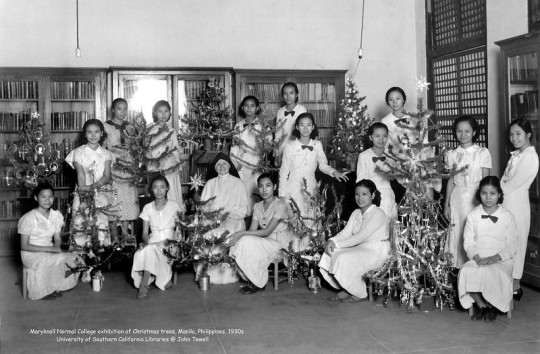
Photograph of the "exhibition of Christmas trees"; at Maryknoll Normal College which features students from the 1930s showing off their Christmas trees that they had created during an art class with Sr. Caritas in the center and art teacher Miss Cristobal at the left-side of the photo at the back. The image was sourced from the University of Southern California Libraries' International Mission Photography Archive, ca.1860-ca.1960, Maryknoll Mission Archives posted by John Tewell (2016) via Flickr.
Filipino Christmas continued to be influenced by non-Hispanic Western Christian countries with the turn of the century and the start of the American colonial era. Traditions like greeting cards which the Americans introduced popularized the figure of Santa Claus and white snow as strong associations with the holiday despite the Philippines never experiencing any snow in its entire history (Roa, 2017).
After the American occupation, Filipino Christmas continued to develop into the modern day adding new traditions stemming from older ones, continuing to change and grow even today.
(Part 2: Practices in the Present Day)
(Reference List)
#mayaposts#mayapino#filipino#philippines#filipino culture#christmas#filipino christmas#history#filipino history#christianity#christian history#traditions#christmas traditions#filipino christmas traditions#colonial history#spanish colonial history#american colonial history#long post
11 notes
·
View notes
Text
Unwrapping Togetherness: Locavore's Holiday Handaan
Embrace the spirit of the season with Locavore’s festive handaan, redefining your Noche Buena classics. Dive into the warmth of cherished holiday memories as Locavore crafts an expanded menu and exclusive dishes, promising a celebration that captures the essence of Filipino Christmas traditions. Crafting Culinary Connections “At Locavore, we believe good food brings people together, and great…

View On WordPress
#Bagnet Buro Mustasa#Bistek Pintxos#Bulalo Pintxos#Celebrate Together#Christmas joy#Christmas Traditions#culinary experience#Eastwood#Estancia-exclusive menu#Family Celebration#Festive Feast#Filipino Christmas#filipino cuisine#Filipino Fusion Cocktails#Gin-based Drinks#Gourmet Filipino#grab food#Handaan#Holiday Memories#Holiday Specials#local ingredients#locavore#Locavore BGC#Locavore Branches#Locavore Cocktails#Manila dining#Mikel Zaguirre#Modern Twist#noche buena#Pickaroo
0 notes
Text

3 notes
·
View notes
Text

Hey, fellow OFWs and working Filipino/a immigrant descendants! If you're looking for some balikbayan box stuffers to make your relatives in the 'Pinas LAUGH the whole Ber months long, have I got something for you!
This is a pack of hot cocoa mix, designed by yours truly! Because in the tropical archipelago nation, the only things changing seasonally in autumn are the music at your local SMs/Robinsons or on your local radio stations as well as the colors on people's porches...
youtube
If you know what I mean.
Check out more seasonal swag on my LATEST collection - Filipino Autumn Stationery, Favors, & Sweets - at my Zazzle store, Construction Paper Eras Nostalgic Stationery & Supplies!
Also, mosey onto the collection - Filipino Autumn Decor & Household Items - for something that complements your kin's' mga parol on porches! It's at Construction Paper Eras Nostalgic Apparel and Life Stuff, BTW.
1 note
·
View note
Text
Someone said my Santa profile pic on fb was 'too early'.
Dawg, I live in the Philippines haha

968 notes
·
View notes
Text

They made up, and Zeri is now teaching them how to make a traditional Filipino parol for Christmas :)
(Reference to this previous art)
#maligayang pasko!#I love these three sm#I love Viktor being a big brother 🥹#jinx#zeri#viktor#machine herald#league of legends#league of legends fanart#jinx arcane#arcane zinx#lol viktor#viktor lol#lol zeri#zeri lol#arcane league of legends#machine herald lol#arcane#Christmas#filipino#artph#mw#mw lol
539 notes
·
View notes